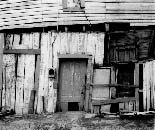William Christenberry
The Contemporary Arts Center, New Orleans
by
G.H. Hovagimyan

'T.B. Hicks' Store Newbern, (Alabama 1991) by Wm. Christenberry
In the US one occasionally sees a report on the disappearance of the family farm in the news. It was not so long ago that most Americans lived on farms or in rural communities. Indeed the Jeffersonian ideal of a self sufficient agrarian democracy is lodged deep within the collective psyche of the America.
On a recent trip to New Orleans I had an occasion to drive along the Mississippi river and stop at some historical farm sites. These are known as plantations. At one such site I viewed a map of the river. The map showed thousands of long narrow plots on the river, one next to the other, which constituted plantation society. River frontage was the key to transporting crops. On each plot the mansion was built very close to the river. The homes would have walkways leading from the front door to a dock. Often live oaks would be planted on either side of the walk to afford some shade.
During my drive I occasionally spied a line of trees marking where a plantation once stood. Due to the nature of the original plot demarcations, a swift sequence of plots and their fate could be viewed. Sugar cane fields followed by, tenant farmer shacks, a restored plantation, a modern one story home on an original foundation, an abandoned mansion, trailers in a cluster, a suburban subdivision called Plantation Park, cluster of live oaks with no building standing, cane fields, modest plantation home and so forth.
This reminded me of a hallucinatory drive through Amish farms outside Iowa City I took with Hans Breder a video artist and head of the Intermedia department at the University of Iowa. On this drive, rich fertile earth and ninteeth century clapboard farms, fresh laundry hanging from clothesline, as a rosy cheeked young man on a horse galloped towards us with his dog running on ahead created an illusion of that self same Jeffersonian ideal. Upon descending a gentle hill we entered in rapid disjunction a modern suburban, two car garage housing subdivision. On both drives I understood how much America has changed since it began.
Almost as if to make a point that his art comes from the Alabama soil, most of William Christenberry's sculptures sit on a pedestal that is topped with the red ochre dirt peculiar to that region. They are in some instances models of clapboard buildings reproduced from color photos. In his retrospective the photographs are mounted on the wall adjacent to a model. The sculptures are painted realistically. In some of the pieces the house is more of an archetypal form than an actual rendering. He calls them dream houses, essentially a cube with a pyramid on top. Corrugated cardboard is used to signify tin sheeting. Snippets of signage are tacked to the sides. The sense is similar to looking at a Robert Rauschenberg collage but with Christenberry the emotion runs deep. One photo shows gourds hanging by wire from a trellis like armature lashed to a split rail fence. Christenberry shares some aesthetic concerns with Joseph Beuys--but his work is home grown. The chance encounter becomes an entrance. RC Cola stamped tin signs, faded from the relentless sun, nailed to the side of a shack are photographed, drawn and salvaged. Their bleached forms, four in a row are nailed onto another exhibition wall. If not saved and brought into art's sacred space the signs would decay and fade to rusted remnants.
The kicker of the whole exhibition is Christenberry's Klan Room. One walks into an enclosed space. Doll fetishes are dressed in white satin Klu Klu Klan outfits with the characteristic peaked hoods. hundreds of them are on display imprisoned in wooden poultry cages, hung as if lynched, wrapped, hidden in a steamer trunk. The vision is of a private ritual, perhaps an exorcism. On the wall behind are backlight photo panels of close viewed clapboard walls aflame. A placard on the exterior of the room tells of how Christianberry turned down many previous offers to exhibit the Klan Room.
Beneath the newly laid out suburban subdivisions is the agrarian soul. Passion, struggle, animosity, forced labor and utopian idealism grow downwards out of sight and mind. The suburban soil produces it's own cult of skin heads and paramilitary. This happens even as a successful exorcism is being viewed within the confines of the Contemporary Art Center.
G.H. Hovagimyan
